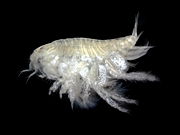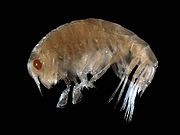
Gammaridea
Encyclopedia
Gammaridea is a suborder of small, shrimp
-like crustacean
s in the order Amphipoda
. It contains about 7,275 (92%) of the 7,900 described species of amphipods, in approximately 1,000 genera
, divided among around 125 families
. Gammaridea includes almost all freshwater
amphipods (such as Gammarus pulex
), as well as many marine lineages. The group may be paraphyletic
, and a 2003 revision by Myers and Lowry moved several families from Gammaridea to join members of the former Caprellidea in a new suborder Corophiidea
.



Superfamily Ampeliscoidea
Superfamily Crangonyctoidea
Superfamily Dexaminoidea
Superfamily Eusiroidea
Superfamily Gammaroidea
Superfamily Hadzioidea
Superfamily Iphimedioidea
Superfamily Kurioidea
Superfamily Leucothoidea
Superfamily Liljborgioidea
Superfamily Lysianassoidea
Superfamily Melphidippoidea
Superfamily Oedicerotoidea
Superfamily Pardaliscoidea
Superfamily Phoxocephaloidea
Superfamily Stegocephaloidea
Superfamily Stenothoidea
Superfamily Synopioidea
Superfamily Talitroidea (includes Phliantoidea)
Superfamily Thurstonelloidea (formerly Clarencioidea)
Incertae sedis
Shrimp
Shrimp are swimming, decapod crustaceans classified in the infraorder Caridea, found widely around the world in both fresh and salt water. Adult shrimp are filter feeding benthic animals living close to the bottom. They can live in schools and can swim rapidly backwards. Shrimp are an important...
-like crustacean
Crustacean
Crustaceans form a very large group of arthropods, usually treated as a subphylum, which includes such familiar animals as crabs, lobsters, crayfish, shrimp, krill and barnacles. The 50,000 described species range in size from Stygotantulus stocki at , to the Japanese spider crab with a leg span...
s in the order Amphipoda
Amphipoda
Amphipoda is an order of malacostracan crustaceans with no carapace and generally with laterally compressed bodies. The name amphipoda means "different-footed", and refers to the different forms of appendages, unlike isopods, where all the legs are alike. Of the 7,000 species, 5,500 are classified...
. It contains about 7,275 (92%) of the 7,900 described species of amphipods, in approximately 1,000 genera
Genus
In biology, a genus is a low-level taxonomic rank used in the biological classification of living and fossil organisms, which is an example of definition by genus and differentia...
, divided among around 125 families
Family (biology)
In biological classification, family is* a taxonomic rank. Other well-known ranks are life, domain, kingdom, phylum, class, order, genus, and species, with family fitting between order and genus. As for the other well-known ranks, there is the option of an immediately lower rank, indicated by the...
. Gammaridea includes almost all freshwater
Fresh Water
Fresh Water is the debut album by Australian rock and blues singer Alison McCallum, released in 1972. Rare for an Australian artist at the time, it came in a gatefold sleeve...
amphipods (such as Gammarus pulex
Gammarus pulex
Gammarus pulex is a species of amphipod crustacean found in fresh water across Eurasia. It is a greyish animal, growing to long.-Description:...
), as well as many marine lineages. The group may be paraphyletic
Paraphyly
A group of taxa is said to be paraphyletic if the group consists of all the descendants of a hypothetical closest common ancestor minus one or more monophyletic groups of descendants...
, and a 2003 revision by Myers and Lowry moved several families from Gammaridea to join members of the former Caprellidea in a new suborder Corophiidea
Corophiidea
Corophiidea is a suborder of amphipods, containing the two suborders Caprellida and Corophiida. It was re-established in 2003 by Myers and Lowry, to contain the taxa previously treated as the suborder Caprellida, together with some families formerly placed in the suborder Gammaridea....
.
Systematics



Superfamily Ampeliscoidea
Ampeliscidae
Ampeliscidae is a family of amphipods, distinct enough to warrant placement in a monotypic superfamily Ampeliscoidea. They are benthic, found at the bottom of seas and oceans. They are distributed worldwide, and are often abundant in areas with fine sediments...
- AmpeliscidaeAmpeliscidaeAmpeliscidae is a family of amphipods, distinct enough to warrant placement in a monotypic superfamily Ampeliscoidea. They are benthic, found at the bottom of seas and oceans. They are distributed worldwide, and are often abundant in areas with fine sediments...
Superfamily Crangonyctoidea
- Allocrangonyctidae
- Artesiidae
- Bogidiellidae
- CrangonyctidaeCrangonyctidaeCrangonyctidae is a family of cave-dwelling freshwater amphipod crustaceans. It contains the following genera:*Amurocrangonyx Sidorov & Holsinger, 2007 *Bactrurus Hay, 1902*Crangonyx Bate, 1859*Lyurella Derzhavin, 1939...
- Crymostygidae
- Falklandellidae
- Kotumsaridae (tentatively placed here)
- Neoniphargidae
- NiphargidaeNiphargidaeNiphargidae is a family of amphipods. It contains the following genera:*Carinurella Sket, 1971*Foroniphargus G. Karaman, 1985*Haploginglymus Mateus & Mateus, 1958*Microniphargus Schellenberg, 1934*Niphargellus Schellenberg, 1938...
- Paracrangonyctidae
- ParamelitidaeParamelitidaeParamelitidae is a family of amphipods, containing the following genera:*Antipodeus Williams & Barnard, 1988*Aquadulcaris Stewart & Griffiths, 1995*Austrocrangonyx Barnard & Barnard, 1983*Austrogammarus Barnard & Karaman, 1983...
- Perthiidae
- Phreatogammaridae
- Pseudocrangonyctidae
- Pseudoniphargidae
- Sternophysingidae
Superfamily Dexaminoidea
- DexaminidaeDexaminidaeDexaminidae is a family of amphipods. It contains the following genera :*Aberratylus Bousfield & Kendall, 1994*Anatylus Bulycheva, 1955*Atylus Leach, 1815*Delkarlye*Dexamine Leach, 1814*Dexaminella*Dexamonica...
- Lepechinellidae
Superfamily Eusiroidea
- Amathillopsidae
- BateidaeBateidaeBateidae is a family of amphipod crustaceans, comprising the single genus Batea, which in turn contains thirteen species:*Batea bousfieldi *Batea campi *Batea carinata...
- CalliopiidaeCalliopiidaeCalliopiidae is a family of amphipods, containing the following genera:*Amphithopsis Boeck, 1861*Apherusa Walker, 1891*Bouvierella Chevreux, 1900*Calliopiella Schellenberg, 1925*Calliopiurus Bushueva, 1986...
- EusiridaeEusiridaeEusiridae is a family of amphipods. It contains the following genera:*Cleonardo Stebbing, 1888*Eusirella Chevreux, 1908*Eusirogenes Stebbing, 1904*Eusiropsis Stebbing, 1897*Eusirus Krøyer, 1845*Harcledo J. L. Barnard, 1964...
- Gammaracanthidae
- GammarellidaeGammarellidaeGammarellidae is a family of amphipods containing three genera:*Austroregia J. L. Barnard, 1989*Chosroes Stebbing, 1888*Gammarellus Herbst, 1793...
- Pontogeneiidae
Superfamily Gammaroidea
- AcanthogammaridaeAcanthogammaridaeAcanthogammaridae is a family of amphipod crustaceans, endemic to Lake Baikal. It contains the following subfamilies and genera:Acanthogammarinae Garjajewia, 1901*Acanthogammarus Stebbing, 1899*Boeckaxelia Schellenberg, 1940...
- AcanthonotozomatidaeAcanthonotozomatidaeAcanthonotozomatidae is a family of Amphipoda comprising five genera :*Acanthonotozoma Boeck, 1876*Acanthonotozomella Schellenberg, 1926...
- AnisogammaridaeAnisogammaridaeAnisogammaridae is a family of small benthic amphipods.-Genera:*Anisogammarus*Barrowgammarus*Carineogammarus*Eogammarus*Eurypodogammarus*Fuxiana*Jesogammarus*Locustogammarus*Ramellogammarus*Spasskogammarus...
- Baikalogammaridae
- Behningiellidae
- Cardenioidae
- Caspicolidae
- Eulimnogammaridae
- GammaridaeGammaridaeGammaridae is a family of amphipods. In North America they are included among the folk taxonomic category of "scuds", and otherwise gammarids is usually used as a common name....
- Gammaroporeiidae
- Iphigenellidae
- Macrohectopidae
- Mesogammaridae
- Micruropodidae
- Pachyschesidae
- PallaseidaePallaseidaePallaseidae is a family of amphipod crustaceans endemic to Lake Baikal. Some species are also found in the Angara River which flows out of Lake Baikal, and one species is distributed throughout Northern Palearctic...
- Pontogammaridae
- Typhlogammaridae
Superfamily Hadzioidea
- Carangoliopsidae
- HadziidaeHadziidaeHadziidae is a family of amphipods, which is difficult to distinguish from the related family Melitidae. It contains the following genera:*Allotexiweckelia*Alloweckelia*Dulzura*Hadzia*Holsingerius*Indoweckelia*Liagoceradocus...
- MelitidaeMelitidaeMelitidae is a family of amphipods. It contains around 45 genera, and formerly included a further 40 genera that are now placed in the family Maeridae.-Genera:*Abludomelita*Allomelita*Alsacomelita*Anchialella*Brachina...
- Metacrangonyctidae
Superfamily Iphimedioidea
- Acanthonotozomellidae
- Dikwidae
- EpimeriidaeEpimeriidaeEpimeriidae is a family of amphipods, containing the following genera:*Actinacanthus Stebbing, 1888*Epimeria Costa, 1851*Metepimeria Schellenberg, 1931*Paramphithoe Bruzelius, 1859*Uschakoviella Gurjanova, 1955-External links:...
- Iphimediidae
- OchlesidaeOchlesidaeOchlesidae is a family of amphipods. They are very small, often less than long, and are found mainly in tropical and subtropical areas of the Southern Hemisphere...
- Vicmusiidae
Superfamily Kurioidea
- Kuriidae
Superfamily Leucothoidea
- Anamixidae
- LeucothoidaeLeucothoidaeLeucothoidae is a family of amphipods. It contains 138 species in 6 genera:*Anamixis Stebbing, 1897 – 21 species*Leucothoe Leach, 1814 – 96 species*Leucothoella Schellenberg, 1928 – 2 species*Nepanamixis Thomas, 1997 – 4 species...
- Pleustidae
Superfamily Liljborgioidea
- Colomastigidae
- LiljeborgiidaeLiljeborgiidaeLiljeborgiidae is a family of amphipods, containing the following genera:*Idunella G. O. Sars, 1894*Isipingus Barnard & Karaman, 1987*Liljeborgia Bate, 1862*Listriella Barnard, 1959...
- Salentinellidae
- SebidaeSebidaeSebidae is a family of amphipods. Its members are disjunctly distributed, occurring in the Mediterranean Sea, eastern and southern parts of the Atlantic Ocean, the southern United States, the Hawaiian Islands, the Indian Ocean, Antarctica and Australia....
Superfamily Lysianassoidea
- AmaryllididaeAmaryllididaeAmaryllididae is a family of marine benthic amphipods found throughout the southern hemisphere. These smooth, laterally compressed amphipods can be distinguished by the accessory setal row of the mandible having a distal tuft...
- Aristiidae
- Cyphocarididae
- Endevouridae
- Eurytheneidae
- LysianassidaeLysianassidaeLysianassidae is a family of marine amphipods.-Genera:*Abyssorchomene*Acheronia*Acidostoma*Acontiostoma*Adeliella*Alicella*Allogaussia*Ambasia*Ambasiella*Ambasiopsis*Apotectonia*Aristiopsis...
- Opisidae
- Podoprionidae
- Scopelocheiridae
- Trischizostomatidae
- Uristidae
- Wandinidae
Superfamily Melphidippoidea
- Megaluropidae
- MelphidippidaeMelphidippidaeMelphidippidae is a family of amphipods which rest upside-down and feed on particles of food suspended in the water. Three genera are recognised:*Melphidippa Boeck, 1871*Melphidippella Sars, 1894*Melphisubchela Andres, 1981...
Superfamily Oedicerotoidea
- Exoedicerotidae
- OedicerotidaeOedicerotidaeOedicerotidae is a family of amphipods. It comprises the following genera:*Aborolobatea Ledoyer, 1984*Acanthostepheia Boeck, 1871*Aceroides Sars, 1895*Americhelidium Bousfield & Chevrier, 1996*Ameroculodes Bousfield & Chevrier, 1996...
- ParacalliopiidaeParacalliopiidaeParacalliopiidae is a family of amphipods....
Superfamily Pardaliscoidea
- Astyridae
- HyperiopsidaeHyperiopsidaeHyperiopsidae is a family of amphipods, comprising the genera Hyperiopsis and Parargissa....
- PardaliscidaePardaliscidaePardaliscidae is a family of amphipods, including the deepest collections made by the Galathea expeditions. It contains the following genera:*Andeepia Biswas, Coleman & Hendrycks, 2009*Antronicippe Stock & Illife, 1990...
- Sicafodiidae
- StilipedidaeStilipedidaeStilipedidae is a family of amphipods, containing the following genera:*Alexandrella*Astyra*Astyroides*Bathypanoploea*Stilipes-References:-External links:*, Crustacea.net...
- Vitjazianidae
Superfamily Phoxocephaloidea
- Cheidae
- Condukiidae
- HaustoriidaeHaustoriidaeHaustoriidae is a family of amphipods. They are very distinctive stout-bodied burrowing animals.The following genera are included in the family:*Acanthohaustorius Bousfield, 1965*Cunicus*Eohaustorius J. L. Barnard, 1957...
- Ipanemidae
- Phoxocephalidae
- Phoxocephalopsidae
- PlatyischnopidaePlatyischnopidaePlatyischnopidae is a family of amphipod crustaceans. Its members are characterised by the conical rostrum, which is covered with sensory pits at the end. Although digging behaviour has only been directly observed in a few taxa, it is assumed that all the animals in the family Platyischnopidae are...
- PontoporeiidaePontoporeiidaePontoporeiidae is a family of amphipods, containing the following genera:*Amphiporeia Shoemaker, 1929*Bathyporeia Lindstrom, 1855*Monoporeia Bousfield, 1989*Pontoporeia Krøyer, 1842*Priscillina Stebbing, 1888...
- Sinurothoidae
- Urohaustoriidae
- UrothoidaeUrothoidaeUrothoidae is a family of small marine amphipod crustaceans. Members of the family are found worldwide and are mainly detrivores and interface grazers, though some are also facultative filter feeders.-Genera:*Carangolia J.L...
- Zobrachoidae
Superfamily Stegocephaloidea
- Stegocephalidae
Superfamily Stenothoidea
- AmphilochidaeAmphilochidaeAmphilochidae is a family of amphipod crustaceans, containing the following genera:*Afrogitanopsis G. Karaman, 1980*Amphilochella Schellenberg, 1926*Amphilochoides Sars, 1895*Amphilochopsis Stephensen, 1925*Amphilochus Bate, 1862...
- Bolttsiidae
- CyproideidaeCyproideidaeCyproideidae is a family of amphipod crustaceans. Eighteen genera and 43 species have been described as of 2009. They mostly occur mostly in the Southern Hemisphere, where they form associations with corals, sponges, crinoids and hydroids.-Genera:...
- Pseudamphilochidae
- Stenothoidae
Superfamily Synopioidea
- Argissidae
- Synopiidae
Superfamily Talitroidea (includes Phliantoidea)
- Biancolinidae
- CeinidaeCeinidaeCeinidae is a family of amphipods. Until 1972, they were considered part of the family Phliantidae. Some genera previously included in this family have been transferred to the family Hyalidae....
- ChiltoniidaeChiltoniidaeChiltoniidae is a family of amphipods, which contains the following genera:*Afrochiltonia K. H. Barnard, 1955*Arabunnachiltonia King, 2009*Austrochiltonia Hurley, 1958*Chiltonia Stebbing, 1899*Phreatochiltonia Zeidler, 1991...
- DogielinotidaeDogielinotidaeDogielinotidae is a family of amphipods. It is currently subdivided into three subfamilies, containing a total of twelve genera:Dogielinotinae Gurjanova, 1953*Allorchestes Dana, 1849*Dogielinoides Bousfield, 1982*Dogielinotus Gurjanova, 1953...
- EophliantidaeEophliantidaeEophliantidae is a family of amphipods, containing the following genera:*Bircenna Chilton, 1884*Ceinina Stephensen, 1933*Cylindryllioides Nichols, 1938*Eophliantis Sheard, 1936*Lignophliantis J. L. Barnard, 1969...
- PhliantidaePhliantidaePhliantidae is a family of isopod-like amphipod crustaceans chiefly from the southern hemisphere.-Description:Members of the family Phliantidae are unusual among the order Amphipoda, because they have dorso-ventrally flattened bodies with a pronouned dorsal keel, rather than being flattened...
- Plioplateiidae
- TalitridaeTalitridaeTalitridae is a family of amphipods. Commonly, many of the North American fresh water species of this family are called scuds. Terrestrial species are often referred to as landhoppers and beach dwellers are called sandhoppers or sand fleas.It contains the following genera:*Africorchestia Lowry &...
- Temnophliantidae
Superfamily Thurstonelloidea (formerly Clarencioidea)
- Thurstonellidae (formerly Clarenciidae)
Incertae sedis
Incertae sedis
, is a term used to define a taxonomic group where its broader relationships are unknown or undefined. Uncertainty at specific taxonomic levels is attributed by , , and similar terms.-Examples:*The fossil plant Paradinandra suecica could not be assigned to any...
- CressidaeCressidaeCressidae is a family of amphipods. The family contains two genera:*Cressa Boeck, 1857*Cressina Stephensen, 1931...
- Didymocheliidae
- Iciliidae
- Lafystiidae
- Laphystiopsidae
- Maxillipiidae
- Nihotungidae
- Pagetinidae
- ParaleptamphopidaeParaleptamphopidaeParaleptamphopidae is a family of amphipod crustaceans, containing three genera. Paraleptamphopus and Ringanui are both endemic to New Zealand, but Rudolphia lives in Chile.-References:...
- Tulearidae
- Valettidae

